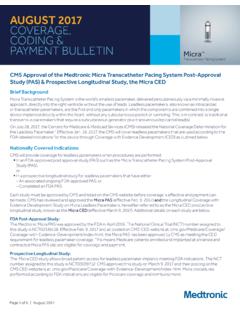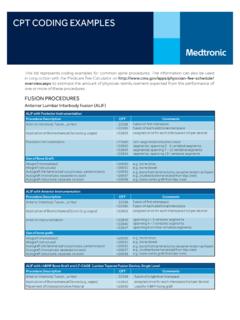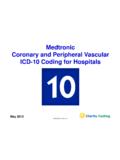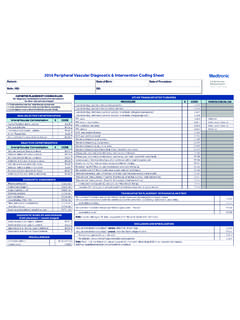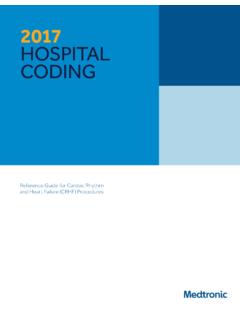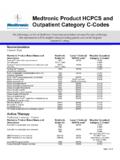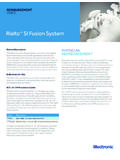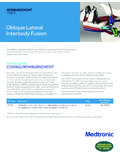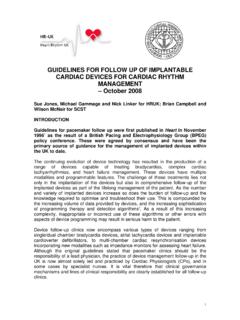Transcription of BLOCK HF Trial Results - Medtronic
1 BLOCK HF Trial Results Superior Outcomes with CRT for Indicated Patients with AV BLOCK *, , 1,2. Clinical Need for a Better Pacing Solution Patients with AV BLOCK have historically received Implant CRT-P or CRT-D. pacemakers and defibrillators; however, evidence has shown that RV pacing may accelerate progression to Establish Optimal Medical Therapy heart failure and increase risk of atrial fibrillation and (RV Paced 30-60 days). death for some ,4. Randomized 1:1. BLOCK HF Trial 1: Objective: Determine if biventricular (BiV) pacing with CRT is superior to right ventricular (RV) pacing Treatment: BiV pacing Control: RV pacing in patients with: Phone follow-up every Phone follow-up every Class I or IIa pacing indication 3 months; echo every 6 months 3 months; echo every 6 months NYHA Class I, II, or III. CRT-P = cardiac resynchronization therapy LVEF 50% (CRT) pacemaker ; CRT-D = CRT defibrillator Double blind, randomized, controlled Minimum 2-month follow-up Enrollment 2003-2011.
2 With at least one of the following: 2nd or 3rd degree AV BLOCK 1st degree AV BLOCK with symptoms similar to pacemaker syndrome Documented Wenckebach or PR interval > 300 ms when paced at 100 ppm BLOCK HF Primary End Point Met**,2. 27% Relative risk reduction in composite of all-cause mortality, heart failure-related urgent care visits, or an increase of 15% or greater in LVESVI. 2. 100. Estimated HR (95% CI). CRT-P AND CRT-D now indicated for patients with: 80 ( , ). PP = AV BLOCK . Event-Free Rate (%). 60. NYHA Class I, II, III heart failure 40. LVEF 50%. BiV Arm 20 Optimal Medical Therapy if indicated RV Arm 0. 0 12 24 36 48 60 72 Subanalysis of primary end point Number at Risk Number of Months showed a 26% relative risk reduction BiV Arm 349 167 91 66 44 24 9 in composite of all-cause mortality RV Arm 342 133 63 41 31 20 11 or heart failure-related urgent care visits.
3 **,5. * Compared to right ventricular pacing. ** Composite of mortality, heart failure-related urgent care visits or a 15% or greater increase in LVESVI. ** Results cannot be interpreted as statistically significant given the lack of pre-specified alpha allocation in evaluation of the Results .. Patients with AV BLOCK and systolic dysfunction.. AV BLOCK expected to require a high percentage of ventricular pacing that cannot be managed with algorithms to minimize right ventricular pacing. Brief Statement: CRT ICDs and CRT. IPGs Indications Cardiac Resynchronization Therapy (CRT) ICDs are indicated for ventricular antitachycardia pacing and ventricular defibrillation for automated treatment of life- threatening ventricular arrhythmias and for providing cardiac resynchronization therapy in heart failure patients who remain symptomatic despite optimal medical therapy if indicated, and meet any of the following classifications: New York Heart Association (NYHA) Functional Class III or IV and who have a left ventricular ejection fraction 35% and a prolonged QRS duration.
4 Left bundle branch BLOCK (LBBB) with a QRS. duration 130 ms, left ventricular ejection fraction 30%, and NYHA. Functional Class II. NYHA Functional Class I, II, or III and who have left ventricular ejection fraction 50%. and atrioventricular BLOCK (AV BLOCK ). that are expected to require a high percentage of ventricular pacing that cannot be managed with algorithms to minimize right ventricular pacing. Optimization of heart failure medical therapy that is limited due to AV. BLOCK or the urgent need for pacing should be done post-implant. Some CRT ICDs are also indicated for use in patients with atrial tachyarrhythmias, or those patients who are at significant risk for developing atrial tachyarrhythmias. The RV Lead Integrity Alert feature is intended primarily for patients who have a Medtronic ICD or CRT-D device and a Sprint Fidelis lead (Models 6949, 6948, 6931, and 6930) based on performance data.
5 The RV LIA feature may not perform as well with a St. Jude Medical Riata /Durata lead or a Boston Scientific Endotak lead as it does when used with a Medtronic Sprint Fidelis lead. This is because different lead designs may have different failure signatures and conditions that may or may not be detected early by the RV LIA feature. CRT IPGs are indicated for NYHA. Functional Class III and IV patients who remain symptomatic despite stable, optimal heart failure medical therapy and have a LVEF 35% and a prolonged QRS duration and for NYHA Functional Class I, II, or III. patients who have a LVEF 50%, are on stable, optimal heart failure medical therapy if indicated and have atrioventricular BLOCK (AV BLOCK ) that are expected to require a high percentage of ventricular pacing that cannot be managed with algorithms to minimize right ventricular pacing.
6 Optimization of heart failure medical therapy that is limited due to AV. BLOCK or the urgent need for pacing should be done post-implant. Rate adaptive pacing is provided for those patients developing a bradycardia indication who might benefit from increased pacing rates concurrent with increases in activity. Dual chamber and atrial tracking modes are indicated for patients who may benefit from maintenance of AV. synchrony. Antitachycardia pacing (ATP) is indicated for termination of atrial tachyarrythmias in patients with one or more of the above pacing indications. Contraindications CRT ICDs are contraindicated in patients experiencing tachyarrhythmias with transient or reversible causes including, but not limited to, the following: acute BLOCK HF Study Baseline Demographics: Treatment Groups Well-Balanced2,5 Primary end point Results favored BiV pacing for all subgroups2.
7 CRT-P CRT-D N Favors BiV Favors RV. >. >. BiV RV BiV RV Overall 691. (N +/- 243) (N +/- 241) (N +/- 106) (N +/- 101). Male 517. % Male2 75% 70% 82% 80% Gender Female 174. Age, years2 74 +/- 10 74 +/- 11 72 +/- 9 71 +/- 10. 35% 208. LVEF, %2 43 +/- 7 43 +/- 7 33 +/- 8 33 +/- 8 Baseline LVEF. > 35% 483. NYHA I2 14% 20% 10% 16%. NYHA II2 58% 52% 63% 57% CLASS I 146. NYHA III2 27% 28% 26% 27% NYHA CLASS II 361. Left Bundle Branch Block5 35% 31% 35% 27% CLASS III 175. 1st Degree AV Block5. 17% 15% 27% 31% 1st Degree 134. 2nd Degree AV Block5 33% 29% 33% 38% AV BLOCK 2nd Degree 227. 3rd Degree AV BLOCK 5. 49% 56% 40% 32% 3rd Degree 329. 0 1 Hazard Ratio (95% CI). Strengths Limitations Study design1 Long enrollment1,2. Longest and largest study of this patient population High cross-over rate5. Consistency of primary Results by subgroups and across crossed over from RV to BiV.
8 Device groups5 pacing crossed over from BiV to RV pacing UC201403501 EN Medtronic , Inc. 2014. Minneapolis, MN. All Rights Reserved. Printed in USA. 05/2014. References 1 . Curtis AB, Worley SJ, Adamson PB, et al. Biventricular pacing for atrioventricular BLOCK and systolic dysfunction. N Engl J Med. April 25, 2013;368(17):1585-1593. 2. BLOCK HF CLINICAL STUDY Clinical study information. Manual Document Number: M955759A001. See World Headquarters Medtronic , Inc. Medtronic USA, Inc. 3. Wilkoff BL, Cook JR, Epstein AE, et al., and the DAVID Trial Investigators. 710 Medtronic Parkway Toll-free: 1 (800) 328-2518 Dual-chamber pacing or ventricular backup pacing in patients with Minneapolis, MN 55432-5604 (24-hour technical support for an implantable defibrillator: the Dual Chamber and VVI Implantable USA physicians and medical professionals) Defibrillator (DAVID) Trial .
9 JAMA. December 25, 2002;288(24):3115-3123. Tel: (763) 514-4000 4. Sweeney MO, Hellkamp AS, Ellenbogen KA, et al., for the MOde Selection Fax: (763) 514-4879. Trial (MOST) Investigators. Adverse effect of ventricular pacing on heart failure and atrial fibrillation among patients with normal baseline QRS. duration in a clinical Trial of pacemaker therapy for sinus node dysfunction. Circulation. June 17, 2003;107(23):2932-2937. 5 . Lautenbach A, Sherfesee L. BLOCK HF Clinical Study Summary. Medtronic data on file. February 2014. myocardial infarction, drug intoxication, drowning, electric shock, electrolyte imbalance, hypoxia, or sepsis; patients who have a unipolar pacemaker implanted, patients with incessant ventricular tachycardia (VT) or ventricular fibrillation (VF), and patients whose primary disorder is chronic atrial tachyarrhythmia with no concomitant VT or VF.
10 CRT IPGs are contraindicated for concomitant implant with another bradycardia device and concomitant implant with an implantable cardioverter defibrillator. There are no known contraindications for the use of pacing as a therapeutic modality to control heart rate. The patient's age and medical condition, however, may dictate the particular pacing system, mode of operation, and implant procedure used by the physician. Rate-responsive modes may be contraindicated in those patients who cannot tolerate pacing rates above the programmed Lower Rate. Dual chamber sequential pacing is contraindicated in patients with chronic or persistent supraventricular tachycardias, including atrial fibrillation or flutter. Asynchronous pacing is contraindicated in the presence (or likelihood) of competition between paced and intrinsic rhythms.

